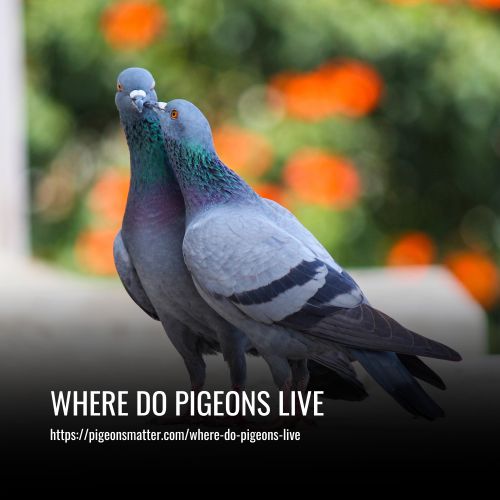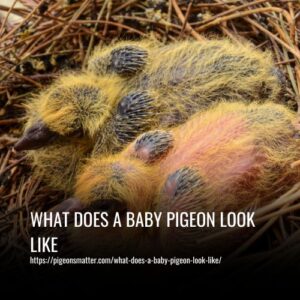Pigeons are commonly found around farm yards, grain elevators, feed mills, parks, city buildings, bridges, and other structures. They can live anywhere with access to food, water, and shelter.
They often nest in holes, building crevices, sheltered ledges, small spaces of tall buildings, flat roofs, balconies, chimneys, solar panels, and anywhere with a safe and regular source of food. Pigeons usually perch up high to avoid predators and human contact.
To safely remove and prevent nuisance birds from returning, comprehensive bird-proofing solutions are available for all types of buildings, garages, warehouses, and historical buildings and monuments.

Where Do Pigeons Naturally Live?
Pigeons naturally live in places where they can build nests on higher ground, which keeps them safe from predators. They prefer closed and confined spaces for protection against adverse weather conditions, such as strong wind, rain, and storms.
The ready availability of food and water is also important, as scarcity of food may cause them to move elsewhere. Recently, there has been an abundance of pigeons in suburban areas, near bridges, and other large structures, due to leftover food thrown out by humans. Pigeons also favor hard surfaces, which increases their interest in staying in such places.
Natural and Man-made Pigeons Inhabit:
Natural pigeon habitats include ledges and under bridges, where feral pigeons can be found. However, truly wild pigeons are mainly seen in coastal areas. Pigeon nesting places can be divided into two prime types: natural and man-made.
Natural pigeon habitats consist of coastal areas where wild pigeons thrive. These areas provide a natural environment with suitable nesting sites and food sources for pigeons to live and reproduce.
Man-made pigeon habitats are created by humans and include ledges and structures on buildings, as well as under bridges. These locations provide feral pigeons with shelter and nesting spaces in urban areas.
1. Natural Habitat:
Feral or inland pigeons can be found in a variety of natural habitats, including urban areas, rural areas, and open fields.
- Urban Areas: In urban areas, pigeons typically build nests on man-made structures, but some flocks can also be found in natural settings such as streetside trees and parks. The massive emergence of woodland pigeons has led to an increased presence of pigeons in urban areas.
- Rural Areas: Wild pigeons prefer nesting on cliffs in rural or coastal areas, while inland pigeons are more commonly found in the countryside, nesting around barns, yards, and trees. Shrublands, wetland trees, forests, and woodlands are prime spots for woodland pigeon habitat.
- Open Fields: Pigeons are not known to build nests in open fields, but they do frequent these areas for food. Inland pigeons may also build resting places close to open fields due to the abundance of food or for safety reasons.
2. Man-Made Environment:
Domestic pigeons have it made in a man-made environment, as their owners build specially designed homes for them in the form of pigeon lofts. These lofts are equipped to meet all of the pigeons’ needs, including food, mating, resting, and roosting. This ensures that domestic pigeons have a safe and comfortable place to call home without having to build it themselves.
In addition to pigeon lofts, pigeons also favor roofs and ledges of buildings in big cities. These structures provide a similar feeling to living on the edge of a cliff, making them an ideal spot for pigeons to roost. However, they can also adapt to other structures and buildings if the location is suitable, such as balconies, cracks in walls, behind gargoyles, or under bridges.
What Kind of Habitat Do Pigeons Prefer?
Pigeons prefer to live close to humans, which is why they are often seen soaring around buildings in big cities. This preference for urban areas explains why feral pigeons are more abundant in cities than wild or woodland varieties.
Despite originating as coastal cliff birds, centuries of domestication and migration have led to diverse living preferences among pigeons. As a result, they can adapt to various environments and are commonly found in urban settings due to their preference for living near humans.
What Is the Natural Habitat of Pigeons in the Wild?
Pigeons in the wild prefer habitats near rocky cliffs and ledges, often inside small caves or openings. These places are elevated from the ground, deterring predators. An ideal habitat has a large food source nearby, such as grain fields or tropical woods with abundant fruits. Pigeons also thrive in rainforests due to the availability of natural food and insects.
They can be found in large groups on islands near water, as well as in mangrove forests, small woods, open land, and even deserts. If food and water become scarce, pigeons will migrate to another location, but they may return to their original habitat after several years.
Can Domestic Pigeons Survive in the Wild?
Domesticated pigeons are bred and raised in a controlled environment, making them unable to survive in the wild. They become dependent on humans for food, water, and overall care, losing their instinct to find resources in the wild.
Furthermore, their long domestication process eliminates their survival instinct, making them vulnerable to predators.
Additionally, they are more susceptible to natural diseases without proper medical attention, leading to a high mortality rate in the wild.
Habitat Distribution And Diversity Of Pigeons:
Habitat distribution and diversity among pigeons is quite impressive. Wild rock pigeons, also known as the species Columba livia, are found in a variety of habitats across North America, North Africa, and Europe. These birds prefer to live near human dwellings such as cliffs, barns, trees, and other structures for safety reasons.
1. Urban Habitat:
- Pigeons thrive in urban landscapes, nesting on building ledges and scavenging for food.
- They navigate the challenges of traffic and pollution with ease, adding a touch of wildlife to our cities.
2. Wild Habitat:
- Pigeons also inhabit diverse wild habitats, from coastal cliffs to dense forests and tranquil islands.
- They exhibit a range of nesting patterns and survival strategies, with diets varying from seeds to small reptiles.
3. Global Distribution:
- Pigeons are found on every continent except the coldest regions.
- They are most diverse in South Asia and Australasia, but also common in Europe, North America, and Africa, making them a truly global species.
Pigeon Adaptability:
Pigeons, also known as rock doves, are incredibly adaptable birds that can be found in urban, suburban, and rural environments around the world. They are known for their ability to thrive in a wide range of habitats and climates.
- Feeding Habits: Pigeons have a flexible diet and can eat a variety of foods, including seeds, grains, fruits, and even human scraps. This allows them to find food in diverse environments.
- Nesting Sites: Pigeons are known for nesting in a variety of locations, including building ledges, bridges, and even window sills. They can adapt to different nesting conditions in urban and natural settings.
- Flight: Pigeons are strong flyers and can easily navigate through different types of environments, from crowded city streets to open rural areas.
- Social Behavior: Pigeons are social birds and can form large flocks, which helps them adapt to changing environments and find safety in numbers.
The adaptability of pigeons allows them to survive and thrive in a wide range of habitats, making them one of the most successful bird species in the world.
Adaptations To Urban Environments:
Urban environments provide a unique set of challenges for pigeons. To adapt to these changing conditions, pigeons have developed several specialized behaviors and adaptations.
1. Physical Adaptations:
Pigeons have robust bodies that allow them to survive in various climatic conditions. Their compact size enables them to navigate through dense city structures, while their strong legs and claws help them perch on different surfaces. Their grey and white plumage provides camouflage in the urban landscape.
2. Behavioral Adaptations:
Pigeons display remarkable resilience in finding food, often scavenging through garbage and consuming human food waste. Their omnivorous diet gives them versatility in city survival. Additionally, pigeons have become tolerant of human presence, fearlessly strutting around populated areas.
Adaptations To Wild Environments:
Wild environments also pose a unique set of challenges for pigeons. To adapt to these conditions, pigeons have developed several specialized behaviors and adaptations.
1. Dietary Habits:
Wild pigeons primarily eat seeds, fruits, and occasionally small insects. Their unique digestive system includes a crop, which allows them to store and even ferment food, enabling them to thrive in various habitats.
2. Breeding Behavior:
Pigeons are monogamous and often breed in pairs for life. This stable breeding structure increases their chances of successfully raising their young. Typically laying one or two eggs at a time ensures they can adequately care for their offspring.
3. Migratory Patterns:
Most pigeons are not migratory, but they are capable of traveling long distances if needed. This non-migratory habit allows them to establish year-round residence in a range of habitats, giving them an advantage over migratory species in terms of food availability and nesting sites.
FAQs
Wild pigeons can survive without humans with no trouble. However, domesticated pigeons are highly dependent on human caregivers for food, shelter, health care, etc. As a result, they are defenseless and don’t survive without humans.
Pigeons are natural omnivores and usually eat seeds, small bugs, various fruits, grains, sunflower seeds, millet, corn, berries, leafy greens, herbs, bananas, watermelons, small insects, snails, spiders, ants, and even human leftovers in suburban areas.
Pigeons prefer higher places to live in since it helps protect them from predators. They also tend to look for places that have food and water available nearby. In the wild, they primarily live in holes in trees, small caves, or on cliffs where they make nests. In urban areas, they are seen to live inside bridges, on top of buildings, and inside other structures.
Pigeons were originally domesticated and kept as pets or used for messenger services. Over time, some pigeons escaped or were released into the wild and were able to survive and reproduce in their new environment. This led to the creation of feral pigeon populations in many cities around the world.
Pigeons originated in Europe, North Africa, and Asia. They were first domesticated over 5,000 years ago in the Middle East and have been bred for various purposes such as racing, homing, and show.
Pigeons’ nests can be found in a variety of locations, including on ledges, in trees, on building roofs, and in other sheltered areas. Pigeons are adaptable and can nest in both urban and rural environments.
Pigeon populations grow so fast because they have a high reproductive rate, with females capable of laying eggs every 6 weeks and producing up to 8-12 eggs per clutch. They also have a short generation time, with young pigeons reaching sexual maturity at just 6 months old.
Conclusion
Preserving and protecting the habitats of pigeons is essential to their survival. Governments and local communities must work together to create a safe environment for these species by protecting natural areas, reducing predation from birds of prey, and managing urban populations.
Additionally, providing access to food sources and limiting human interference during the nesting season are also important steps toward conserving pigeon populations. Through these efforts, we can ensure that these majestic birds will continue to thrive for generations to come.



